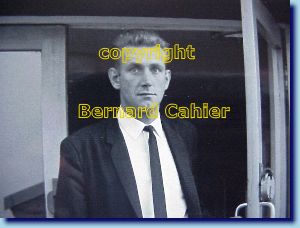
...when he was young, in front of his office
Picture copyright Bernard Cahier/F
"Thanks for calling, Wolfgang
Good to know, there are enthusiasts in Germany. I am really surprised about the hype that the Mustang gets in vintage racing again these days. What would you like to know?"Thanks for your time, Alan, I am glad this interview finally happened. Special thanks to your secretary Shirley as well. O.k, here we go:
Editors note: Alan Mann passed away on March 21st., 2012. RIP.
His ex-mechanic John Grant contacted us by that time:
"Alan will be remembered for his work on the original Mustangs both in racing and rallies and I think that true Mustang fans know this... Alan was a great boss and a great guy and I will always feel it an honour to have known and worked for him."
Can you let us know something about your race activities before the Mustang came to Europe?
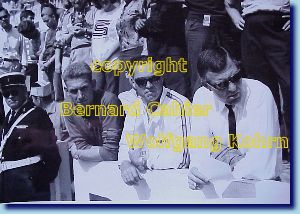
A.Mann: Well, you can read a lot about our GT40 engagements, then we raced Cobras and we got 14 Falcon Rallye Sprints, of which we entered 8 in the Rallye Monte Carlo. Bo Ljungfeldt was second there in the total classifying and winner in its class. I met Carroll Shelby in Daytona first, he was and is a nice guy and we sort of cooperated in case of the Cobras. We were working on many projects aside from that.
When did you first get knowledge about the oncoming Mustangs and were you involved in their development?
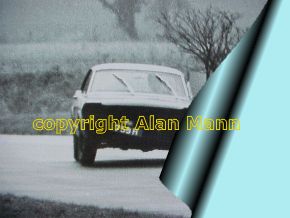
Most probably an Allan Plant car 5S07_100003, the test car sent to Alan Mann for suspension evaluation
A.Mann: Well, this is still a secret, but we got one of the Mustang prototypes for testing in very early 1964 from Ford USA, even before the first serial production Mustangs were presented. They gave it to us to do some testing of the performance and we checked it all over, then gave our comment and detailed report to them. We kept this early prototype and homologated it for European touring car class homologation. It was raced later as well. Unfortunately I do not recall, what happened to the car, but I think we used it as a car for spare parts.

The same test car being stored at Roy Pierpoints garage
This is really top notch information -
Do you remember the exact date, when you got it? You might know that serial production is said to have started on 5th. of March with Mustangs being built from 5F0__100001 through 5F0__100148.
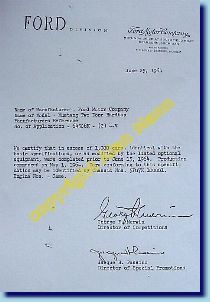
A.Mann: I remember it must have been end of February. It was still very cold outside, but I cannot exclude the very first days of March. When we got it, we had to hide it as a secret project somewhere else.
It was stored at Roy Pierpoints Heavy Vehicles facility, where Lionel and Roy (last names withheld due to current interviews) grafted on all the rally Falcon suspension with some small improvements. I enclose some pictures, which are probably the only ones ever taken of this car. The picture of me testing the car at Goodwood shows all the identifiying marks removed as it was still a Top Secret vehicle. This test vehicle came initially with a small V8 (probably the 260) and a 3-speed gearbox.
(In a short interview with Lionel the "#3" on the car was confirmed)
The Mustang was an easy to drive car, easier than the Falcon, although it was the same platform. Following successful testing, homologation papers were drawn up. We presented the pictured Ford document with the application papers. (see left column)
There is a funny story with that. Initially we had sent the same letter to Paris with signatures from Merwin and Passino showing "Manager" titles. This confirmation letter was not accepted, FIA complained about the level of signers, it should have been something higher, they said. We requested a second letter from Ford and the same guys Merwin and Passino this time signed as "Directors". This letter was approved. The confirmation about the 1000 built cars says nothing about the K-code Mustangs number. While the FIA checked the total number of Minis very accurate, they apparently trusted in the success of the Ford Mustang enough, not to ask for further documentation. As you can see the process was complete by June 25th 1964, when homologation was applied for.
It is assumed that you got some of the first pre-production Mustangs built before March 9th 1964. The Production Guide of Jim Smart/Jim Haskell lists the following Mustangs with VIN 5F07F100025, 5F07F100026, 5F07F100027, 5F07F100030 and 5F07F100055. However it says they went via Ford of France to you. There are records that you received 11 Mustangs in total. We have a copy of an invoice from Ford files, indicating that you received from Henri Carlini, Special Promotions Dept. Of Ford in middle of July, invoiced on 6th. of August following additional Mustangs: 5F07K208109, 5F07K208110, 5F07K208111, 5F07K208112. Were these maybe the Tour de France cars or the earlier ones? Did they arrive at your shop and what did you actually modify on the cars for the Tour de France.
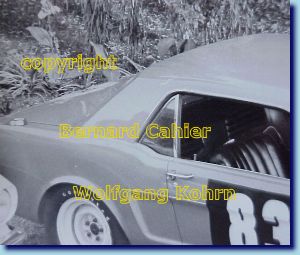
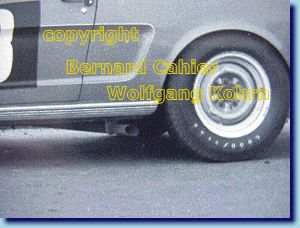
These are only small cut-outs of the B. Cahier pics. They are strictly subject to copyright laws.
A.Mann: We got 4 red Mustangs for TDF and 2 white ones earlier for Liege, in total I remember only those 6 Mustangs plus the prototype, that we got, not 11. I do not know the VINs. The later TDF cars were already red in colour, when they arrived. We prepared 3 actually for the Tour de France drivers Peter Procter, Peter Harper and Bo Ljungfeldt, while we took the 4th car as a spare with us. At the TDF I drove the 4th car sometimes, but not at the race, later we had to take out some parts of this car, as we needed them on one of the TDF Mustangs.
When they arrived at our shop, we first took the 260 engines out and tossed them, then we installed 289s, which were prepared by Holmann-Moody and did a lot of other modifications.
Remark: In earlier 1988 dated interview with Jeffrey Harris, Alan Mann still recalled some of the modifications: The front suspension was modified with standard Heavy-duty parts at that ime that were also used on the Rallye Falcons and originated in some cases fromt the Galaxy. The parts that were from the full-size Ford Galaxy had much more strength to withstand a harsh rallye like the TDF. The brakes were upgraded to Girling disc brakes as all Racing Fords were at that time. The third member was a Detroit locker, they were very harsh and brutal, they came in with a bang, it was the only one that would really last with the huge torque of the V8.
We installed Panhard rods on the third member, but the chassis of some of the cars cracked during TDF and we had to do some welding job. Our service Econoline vans had welding equipment on board.
The engines were quite standard racing engines from John Holman, at least "more or less". We had Highrise intakes on them and Holly carburetors added. The oil pan was a bigger one with baffles. You can see this in the Tour de France photos. A 60 ampere alternator was installed in place of the standard generator. With this alternator we could run 6 to 8 headlights. The radiator was not the standard Mustang unit, but most likely a Ford Heavy duty unit. The sound deadener was removed for weight, but due to the other equipment it was not a big gain overall. The gas tank was actually made of two welded together "with lots of baffling" and most likely a bottom piece under the car to protect it from damage when it bottomed out.
The exhaust was shortened, the pipes did not go over the axis, as that could break or cause problems during the rally. No muffler or silencers as the brits call them, just expansion chambers.
And about the VINs and early/late Mustangs?
A.Mann: As I said I do not remember the VINs. I don't think we got 11 Mustangs. We got only 6 and the prototype. That's it. The Tour de France was in September 1964. That makes pretty much sense that the later ones were the TDF cars. We got 2 white Hardtops after the test car, for the Liège-Sofie-Liège rally.
* Ed: Brian L., one of the mechanics confirmed and remembers also only the test Mustang, 2 white early 'stangs for Liege and 4 for the Tour de France.
Which was the first race you entered one or any Mustang?

Picture courtesy Ford USA - 100 years of Racing History
A.Mann: The first race was the Liège-Sofie-Liège rallye in August 1964. (Editorial note: Distance 6000km - 98 participants- only 21 arrived).
Bo Ljungfeldt drove a Mustang. The other one was driven by Procter/Harper. Both cars crashed. We had some electric problems on Bo's car in the beginning, which we could manage - at least we thought so.
At one time one of the rear tires of the Procter Mustang exploded. It really blew up. At first we did not know what happened, but then it turned out, that they were driving with the handbrake applied for an extended period and that caused the brake and tire to develop extensive heat. Obviously the rear tire could not stand the immense heat and literally exploded. We had to change tire and off it went again. Other then that there were only minor things to repair.
But later we had a major problem with the electricity on Bo's car. Suddenly the on-board-circuit failed and Bo was left with no headlights in the dark. Bo went with the Mustang in a corner 40ft down a road side and hit some pine trees. It was near Bled/Yugoslawia. The co-driver - Harper - who was pretty well, went back the road to alarm us, and we headed back to the incident site, but could hardly find it in the dark. Harper had said, that he walked exactly 10 minutes. His clock stopped at 11.36pm, so he knew exactly. We went back and walked again 10 minutes in the dark. Then we found him down there. Fortunately Bo was not heavily injured and no blood. We could not get the Mustang out there. It took us quite a while to find a crane, so we could get him out from down there. So, we did not finish, of course. The car could be repaired - there were only major roof dents. It used it later as well in the Brands Hatch Race/UK in December 1965 next, where I drove the Mustang the last time. In fact I raced myself Mustangs only on 2 occasions.
Did you have a small team compared to the other Tour de France teams?
A.Mann: Not so, I had 25 to 30 people working at that time and we were a really well organized team with full support for the drivers. We had several Service cars with us and although there was little time to do repairs on the Mustangs, we never had a major problem with technical support. Sometimes we had to shift one or the other repair to the next Etappe, but that did not cause any problems. Our TDF team was a perfect one, especially in those times. Indeed we had to help the Porsche team out with our service. The Huschke von Hanstein team even did not have welding equipment on their service van. The Porsches had some suspension cracks in the final 3 days and actually we did some welding on their cars to keep them in the race. Those were the times, when everybody was even helping his competitors. As the result showed they (the Porsche) were not really competitive in such an endurance race. BTW - Two guys of my old race team are still around in my company right now.
I have read that the Service cars - the Econoline Vans were equipped with 427 big block engines? Is that true?
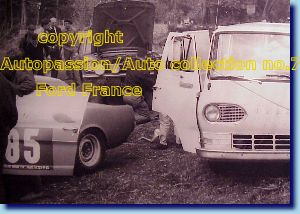
Ford Econolines were used by Alan Mann Racing as racing service vehicles. One of them - a green one - had a 427 (or rather a 390) built in by Holman Moody. (See remark on right)
A.Mann: Only one had a 427. It was installed by John Holmann and it came to us in green colour. The others (about 8) had standard engines. We used those over the years as our service wagons and they were very reliable and good cars. We had a lot of fun with this special 427 engined car. It was really brute. I do not remember what happened to it afterwards. I guess it was sold here in the U.K.
Ed: Rumours are around that the 427 Econoline was crashed in a speed accident later.
John Grant (mechanic of Alan Mann later told us it was definitely not a 427, but a 390. He said he should know as he worked on it and later was working also on drag cars like the 427 Mustang brought over to Santa Pod. He was absoulutely sure it was not a 427 in that Econoline, but a 390.
Do you remember any other incidents of the TDF 1964 and what was your experience with the Mustangs?
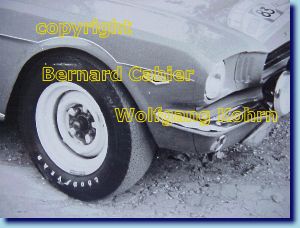
A.Mann: Well, the Mustangs prooved to be very reliable and durable in their modified status. In fact we had only little problems with them. The incident that took Bo Ljungfeldt out of the race was an electricity failure again. The car simply did not start any more. He was later disqualified, but finished this race at Pau anyway.
Basically the first 5 days of the TDF are important for the victory of the race. I was intially driving the 4th spare car during the TDF from race to race, but we later had to take parts of it for the rallye cars. I remember that on one car the rear shock absorber plates broke and we had to dismount them from the spare car. We also used some other parts of the car for replacement.
Not yet bored? - Please click here for Part 2
Special Note:
Copyright will be secured and violators prosecuted by any means. I am very professional in public relations (it is my job), so think about the risk of
being flamed in public. And I am not afraid of legal actions anyway.
But...if you have any further information or pictures,
please send an E-mail to me